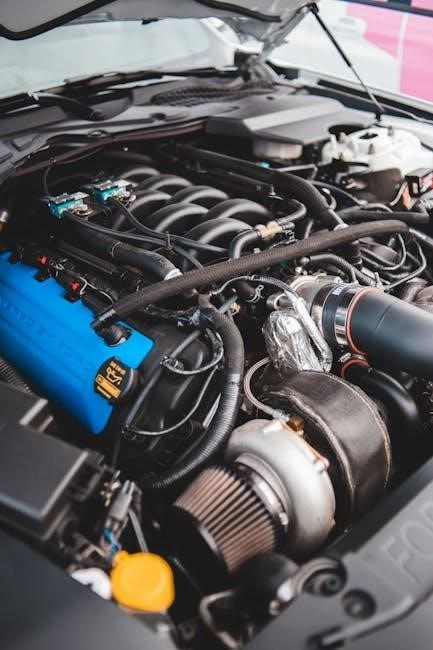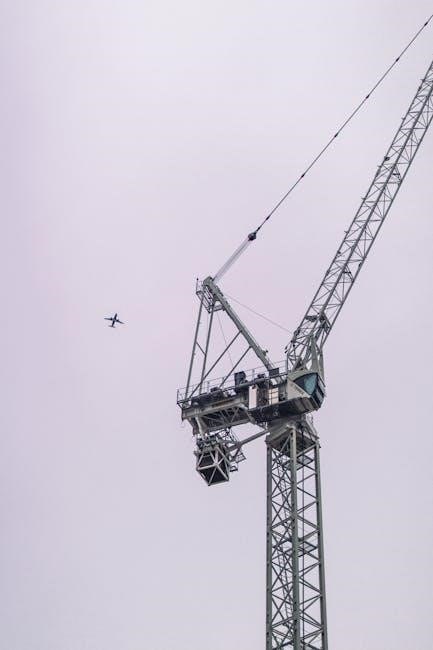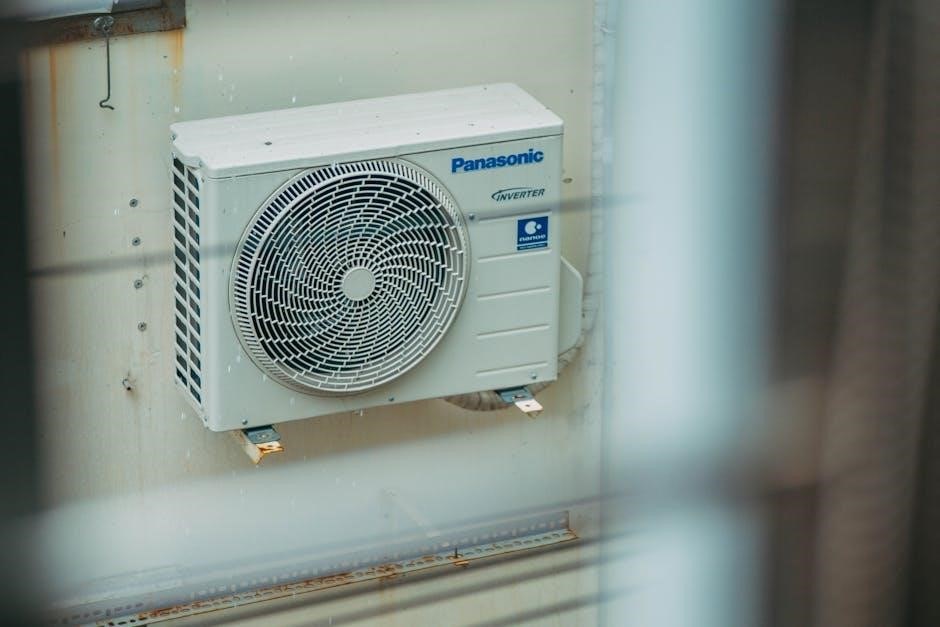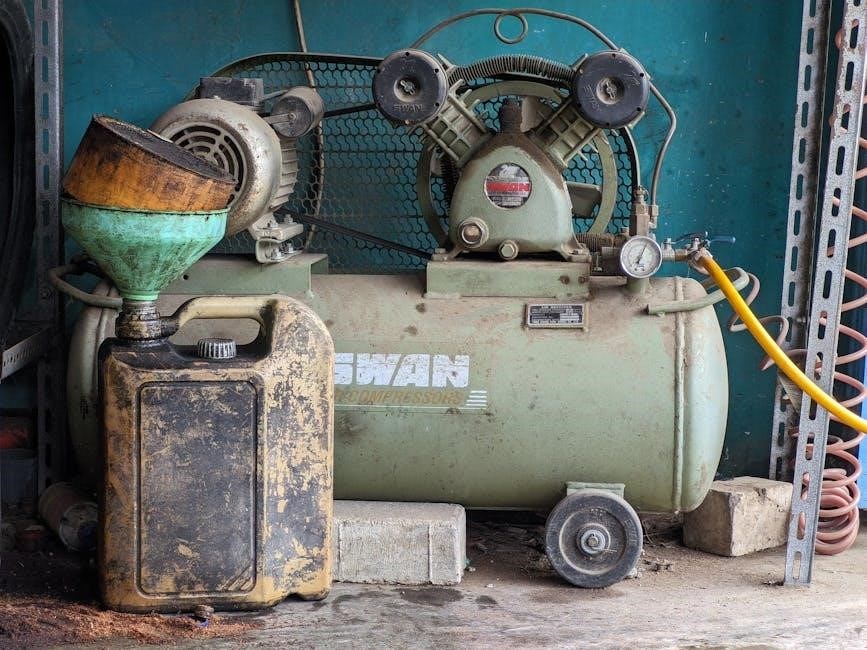Welcome to the Porter Cable 150 PSI Air Compressor Manual‚ your guide to safe and effective operation of this powerful 10-gallon air compressor system․
Reading this manual is essential for understanding proper setup‚ usage‚ and maintenance to ensure optimal performance and safety while operating the compressor․
1․1 Overview of the Porter Cable 150 PSI Air Compressor
The Porter Cable 150 PSI Air Compressor is a versatile and powerful tool designed for various applications‚ including inflating tires‚ powering pneumatic tools‚ and supporting DIY projects․ With a maximum pressure of 150 PSI‚ it delivers reliable performance for both light-duty and heavy-duty tasks․ This compressor features a 10-gallon tank‚ ensuring extended runtime and reduced cycles․ Its compact design and durable construction make it a popular choice for professionals and homeowners․ The unit operates on a 50% duty cycle‚ meaning it should not run more than 50% of the time in a one-hour period to prevent overheating and extend its lifespan․
1․2 Importance of Reading the Manual
Reading the Porter Cable 150 PSI Air Compressor manual is essential for ensuring safe‚ efficient‚ and proper operation of the unit․ The manual provides critical information about safety precautions‚ technical specifications‚ and maintenance requirements․ By understanding the compressor’s features and limitations‚ users can avoid accidents and optimize performance․ It also guides users through installation‚ startup‚ and troubleshooting processes‚ helping to prevent costly repairs․ Additionally‚ the manual outlines warranty terms and conditions‚ ensuring users are aware of their coverage and responsibilities․ Taking the time to thoroughly read and follow the manual guarantees a safer and more effective experience with the air compressor․
1․3 Safety Precautions and Warnings
The Porter Cable 150 PSI Air Compressor manual emphasizes critical safety precautions to ensure user safety and prevent accidents․ Always wear protective gear‚ including safety glasses and gloves‚ when operating the compressor․ Ensure the workspace is well-ventilated to avoid inhaling compressed air or fumes․ Never exceed the maximum pressure rating of 150 PSI‚ as this could lead to equipment failure or injury․ Use only hoses and accessories rated for at least 150 PSI to prevent ruptures․ Regularly inspect the air tank and components for damage or leaks․ Follow all safety guidelines to avoid hazards associated with compressed air‚ such as flying debris or loud noises․

Safety Guidelines for Operating the Porter Cable 150 PSI Air Compressor
Always wear safety goggles and ensure proper ventilation․ Regularly inspect hoses and connections for leaks․ Operate on a 50% duty cycle to avoid overheating․
2․1 General Safety Rules
Safety is paramount when operating the Porter Cable 150 PSI Air Compressor․ Always wear safety goggles and ensure proper ventilation in the workspace․ Avoid overloading the compressor beyond its rated capacity․ Keep loose clothing and long hair tied back to prevent entanglement․ Never leave the compressor unattended while in operation․ Ensure the area is clear of flammable materials and sparks․ Follow the recommended duty cycle (50%) to prevent overheating․ Regularly inspect hoses and connections for leaks or damage․ Keep children and unauthorized individuals away from the compressor․ Adhere to all warnings and guidelines provided in the manual to ensure safe operation․
2․2 Handling Compressed Air Safely
Handling compressed air requires careful attention to safety․ Always use hoses and fittings rated for at least 150 PSI to prevent rupture․ Never exceed the maximum pressure rating of the compressor or attached tools․ Avoid using compressed air for cleaning clothing or body parts‚ as it can cause serious injury․ Ensure the compressor is turned off and depressurized before performing maintenance․ Use the safety valve to bleed air from the tank until pressure drops to approximately 20 PSI․ Regularly inspect air lines for damage or leaks․ Never direct compressed air at people or animals‚ and avoid breathing compressed air‚ as it may contain contaminants․
Always follow the recommended duty cycle (50%) to avoid overheating․ Keep the compressor away from flammable materials and open flames․ Use only approved tools and accessories designed for compressed air systems․ If unsure about any operation‚ consult the manual or contact Porter-Cable support for guidance․
2․3 Precautions for Avoiding Accidents
To prevent accidents‚ always ensure the compressor is placed on a stable‚ level surface and keep the area clear of obstructions․ Regularly inspect hoses‚ fittings‚ and connections for signs of wear or damage‚ replacing them immediately if necessary․ Avoid overloading the compressor by adhering to the 50% duty cycle to prevent overheating․ Never use the compressor near open flames or in areas with flammable materials․ Ensure all users are properly trained and wear protective gear‚ such as safety glasses‚ when operating tools․ Always turn off the compressor and depressurize the system before performing maintenance or repairs․ Follow all safety guidelines outlined in the manual to minimize risks․
2․4 Emergency Procedures
In case of an emergency‚ immediately shut off the compressor’s power supply and engage the safety valve to release stored air pressure․ Evacuate the area if you suspect a gas leak or overheating․ Never attempt to restart the compressor until the issue is resolved․ If the compressor malfunctions‚ unplug it and contact an authorized service center․ Always drain the tank pressure to approximately 20 PSI before performing any maintenance․ Keep a fire extinguisher nearby and avoid using the compressor in hazardous environments․ Follow the manual’s guidelines to ensure safe operations and minimize risks during emergencies․

Technical Specifications of the Porter Cable 150 PSI Air Compressor
The Porter Cable 150 PSI Air Compressor features a 10-gallon tank‚ delivering 3․7 SCFM at 40 PSI and 2․6 SCFM at 90 PSI‚ ensuring reliable performance for various tasks․

With a maximum pressure rating of 150 PSI‚ it supports tools like nail guns and tire inflators‚ making it a versatile choice for both home and professional use․
3․1 Key Features and Capabilities
The Porter Cable 150 PSI Air Compressor boasts a robust 10-gallon tank‚ delivering 3․7 SCFM at 40 PSI and 2․6 SCFM at 90 PSI․ Key features include a maximum pressure rating of 150 PSI‚ ensuring efficient performance for tools like nail guns and tire inflators․ Its compact design and portability make it ideal for both home and professional use․ The compressor operates on a 50% duty cycle‚ allowing for continuous operation without overheating․ With a cut-in pressure of 120 PSIG and cut-out at 150 PSIG‚ it provides consistent air flow․ Additional capabilities include easy-to-use controls and a durable construction for long-lasting reliability․
3․2 Performance Ratings (SCFM at 40 PSI and 90 PSI)
The Porter Cable 150 PSI Air Compressor delivers a performance rating of 3․7 SCFM at 40 PSI and 2․6 SCFM at 90 PSI․ These ratings indicate the compressor’s airflow capacity at different pressure levels‚ ensuring compatibility with a variety of pneumatic tools․ The higher SCFM at 40 PSI makes it suitable for tasks requiring consistent airflow‚ while the slightly lower SCFM at 90 PSI balances performance for heavier applications․ These ratings are essential for understanding the compressor’s ability to power tools efficiently‚ ensuring optimal performance across different operational demands․
3․3 Maximum Pressure Rating (150 PSI)
The Porter Cable 150 PSI Air Compressor is designed to operate at a maximum pressure rating of 150 pounds per square inch (PSI)․ This rating ensures the compressor can handle demanding tasks‚ such as powering pneumatic tools‚ inflating tires‚ and supporting heavy-duty applications․ The 150 PSI capacity provides a reliable and consistent air supply‚ making it suitable for both professional and DIY projects․ Always ensure that all connected tools and hoses are rated for at least 150 PSI to maintain safety and performance․ This maximum pressure rating underscores the compressor’s versatility and capability to meet various air power requirements efficiently․
3․4 Air Tank Capacity and Dimensions
The Porter Cable 150 PSI Air Compressor features a 10-gallon air tank‚ designed to provide sufficient air storage for continuous operation․ Its compact dimensions‚ approximately 19․5 x 15 x 20 inches‚ make it portable and easy to fit in various workspaces․ The tank is constructed from durable materials to ensure long-lasting performance and safety․ With a cut-in pressure of 120 PSIG and a cut-out pressure of 150 PSIG‚ the compressor delivers consistent airflow‚ producing 3․7 SCFM at 40 PSI and 2․6 SCFM at 90 PSI․ These specifications ensure reliable performance for tools and applications requiring steady air pressure․

Installation and Setup Instructions
Proper installation and setup are crucial for safe and efficient operation․ Unpack and inspect the compressor‚ then choose a well-ventilated location․ Ensure electrical requirements are met before initial setup and preparation․

4․1 Unpacking and Initial Inspection
Begin by carefully unpacking the Porter-Cable 150 PSI Air Compressor from its box․ Inspect the unit for any visible damage or dents sustained during shipping․ Verify that all components‚ including the air tank‚ compressor motor‚ and accessories‚ are included․ Check for any signs of leaks or defects․ Ensure the compressor is placed on a level‚ stable surface in a well-ventilated area․ Before powering on‚ familiarize yourself with the manual to understand proper setup and operation․ This step ensures safety and optimal performance for your air compressor․ Any damage should be reported immediately to the manufacturer or supplier․
4․2 Choosing the Right Location for Installation
Selecting a suitable location for your Porter-Cable 150 PSI Air Compressor is crucial for safe and efficient operation; Ensure the area is well-ventilated to prevent the accumulation of compressed air gases․ Place the compressor on a level‚ stable surface to maintain balance and prevent vibration․ Choose a location with easy access to electrical power‚ as the unit requires a reliable power source․ Avoid direct sunlight‚ moisture‚ or extreme temperatures‚ as these can affect performance and longevity․ Keep the compressor away from flammable materials and ensure proper clearance for airflow․ This setup ensures optimal functioning and safety for your air compressor system․
4․3 Electrical Setup and Requirements
Ensure your Porter-Cable 150 PSI Air Compressor is connected to a properly grounded electrical outlet rated for 120V‚ 15A․ Use a dedicated circuit to avoid overloading and ensure stable power supply․ Never use extension cords‚ as they may cause voltage drops or safety hazards․ Install the compressor on a circuit with a suitable breaker or fuse to handle the unit’s power requirements․ For added protection‚ consider using a GFCI-protected outlet‚ especially in damp environments․ Always follow local electrical codes and consult a licensed electrician if unsure․ Proper electrical setup ensures safe and reliable operation of your air compressor system․
4․4 Initial Setup and Preparation
Begin by unpacking and inspecting the compressor for any damage or defects․ Ensure all components‚ including the air tank‚ motor‚ and gauges‚ are securely attached and functioning properly․ Connect the necessary hoses and accessories according to the manufacturer’s guidelines․ Before first use‚ drain the air tank to remove any moisture or debris that may have accumulated during shipping․ Turn the compressor on briefly to test its operation and check for any air leaks․ Ensure the area is well-ventilated and free from flammable materials․ Familiarize yourself with the controls and settings to prepare for safe and efficient operation․

Operating the Porter Cable 150 PSI Air Compressor
Operate the compressor by starting the motor‚ allowing it to build pressure‚ and adjusting the regulator as needed for your tools․ Always follow safety guidelines to ensure efficient and safe operation․
5․1 Starting the Compressor
To start the Porter Cable 150 PSI Air Compressor‚ ensure the tank pressure is at or below 20 PSI by draining excess air using the safety valve․ Plug in the compressor‚ turn the switch to the “on” position‚ and allow it to build pressure․ Monitor the pressure gauge to ensure it does not exceed the maximum rated pressure of 150 PSI․ Once the compressor reaches its cut-out pressure‚ it will automatically shut off․ Always ensure the compressor is on a level surface and all connections are secure before starting․ Follow these steps to ensure safe and efficient operation․
5․2 Adjusting the Pressure Regulator
To adjust the pressure regulator on your Porter Cable 150 PSI Air Compressor‚ start by turning the regulator knob clockwise to increase pressure or counterclockwise to decrease it․ Always set the pressure to match the requirements of your air tool or accessory․ Use the pressure gauge to monitor the output pressure‚ ensuring it does not exceed the maximum rated pressure of 150 PSI․ After adjusting‚ test the system by operating the tool to confirm the pressure is stable and appropriate for your application․ Proper adjustment ensures efficient performance and prevents damage to connected equipment․
5․3 Using the Air Compressor with Tools
Connect your air tools to the Porter Cable 150 PSI Air Compressor using the correct quick-connect couplers․ Ensure the tool is rated for the compressor’s maximum pressure of 150 PSI․ Always set the pressure regulator to match the tool’s requirements‚ as specified in its manual․ Before use‚ check for air leaks in the hose and connections․ Operate the tool according to its instructions‚ monitoring performance to ensure optimal results․ Turn off the compressor when not in use to conserve energy and maintain safety․ Proper tool usage enhances efficiency and prevents potential damage to both the compressor and the connected equipment․
5․4 Monitoring Compressor Performance
Regularly monitor the compressor’s performance to ensure it operates efficiently and safely․ Check the pressure gauge to confirm it reaches the set cut-out pressure of 150 PSI and cycles off properly․ Listen for unusual noises or vibrations‚ which may indicate wear or misalignment․ Ensure the compressor shuts off automatically when the tank is fully charged․ Verify that the duty cycle does not exceed 50%‚ as specified‚ to prevent overheating or overwork․ Drain moisture from the tank daily to avoid rust and maintain air quality․ Regular monitoring helps extend the compressor’s lifespan and ensures reliable performance for all your pneumatic tools․

Maintenance and Upkeep
Regular maintenance ensures the compressor operates efficiently and prolongs its lifespan․ Perform daily checks‚ replace air filters‚ lubricate moving parts‚ and drain the tank to maintain optimal performance․
6;1 Daily Maintenance Checks
Daily maintenance is crucial for optimal performance and longevity of the Porter Cable 150 PSI Air Compressor․ Begin by draining moisture from the tank to prevent rust and corrosion․ Inspect the air filter and clean or replace it as needed to ensure proper airflow․ Check for any leaks in hoses‚ connections‚ and gaskets‚ addressing them promptly․ Verify the belt tension and lubricate moving parts to reduce friction․ Monitor the pressure gauge and ensure it operates within the recommended range․ Regularly inspect electrical connections for damage or wear․ By following these steps‚ you can maintain efficiency‚ safety‚ and reliability of the compressor․
6․2 Draining the Air Tank
Draining the air tank is essential to remove accumulated moisture‚ preventing rust and corrosion․ Locate the drain valve at the bottom of the tank and open it‚ allowing all moisture to escape․ Use the safety valve if equipped‚ pulling the ring to release pressure․ Drain the tank daily after use‚ especially in humid environments․ Ensure the tank is completely dry before closing the valve․ Regular draining helps maintain the compressor’s efficiency and extends its lifespan․ Always follow safety guidelines when performing this task to avoid any potential hazards․ Proper maintenance ensures reliable performance and safety of the Porter Cable 150 PSI Air Compressor․
6․3 Replacing Air Filters
Regularly replacing the air filters is crucial for maintaining the performance and efficiency of your Porter Cable 150 PSI Air Compressor․ Turn off the compressor and unplug it before starting the replacement process․ Locate the air filter‚ typically found on the intake side of the compressor․ Remove the old filter and inspect it for dust and debris․ Install a new‚ compatible filter‚ ensuring it is securely fastened․ Replace the filter every 1-3 months or as recommended in the manual․ Clean or replace the filter more frequently in dusty environments to prevent reduced airflow and potential damage to the compressor․ Proper filtration ensures optimal operation and longevity of the unit․
6․4 Lubricating Moving Parts
Lubricating the moving parts of your Porter Cable 150 PSI Air Compressor is essential for smooth operation and longevity․ Use a high-quality oil suitable for air compressors‚ applying a few drops to moving components like piston seals and valve stems․ Lubricate every 50 hours of use or as specified in the manual․ Avoid over-lubrication‚ as it can attract dust and reduce efficiency․ Regular lubrication prevents friction-related wear and ensures optimal performance․ Always turn off and unplug the compressor before lubricating; Proper maintenance helps maintain the compressor’s efficiency and extends its lifespan‚ ensuring reliable service for years to come․

Troubleshooting Common Issues
Identify and resolve common problems like compressor not starting‚ low pressure‚ or strange noises․ Check power supply‚ fuses‚ and pressure settings․ Inspect for air leaks and worn parts․ Ensure proper lubrication and drain moisture regularly to maintain efficiency and prevent breakdowns․ Refer to the manual for detailed solutions and safety guidelines․ Regular maintenance and prompt issue resolution will extend the compressor’s lifespan and ensure reliable performance․ Always follow safety precautions when troubleshooting to avoid accidents or further damage․ Proper care and attention will keep your Porter Cable compressor running smoothly for years․ Address issues promptly to maintain optimal functionality․
7․1 No Reset Button on the Compressor
If your Porter Cable 150 PSI air compressor does not have a reset button‚ ensure safety by turning it off and unplugging it before troubleshooting․ Bleed pressure from the tank until it reaches approximately 20 PSI․ Check the power supply‚ fuses‚ and circuit breakers to ensure they are functioning properly․ Verify that the tank is not over-pressurized‚ as this can prevent the compressor from starting․ If issues persist‚ inspect for air leaks or blockages and ensure all components are properly lubricated․ Restart the compressor and monitor its performance; Always follow safety guidelines to avoid accidents or further damage to the unit․
7․2 Compressor Not Starting
If the Porter Cable 150 PSI air compressor fails to start‚ first ensure the power supply is stable and the circuit breaker or fuse is intact․ Verify that the tank pressure is not exceeding the cut-out pressure of 150 PSI‚ as this can prevent the motor from engaging․ Check for air leaks in the system‚ which may relieve pressure and prevent startup․ Ensure the pressure relief valve is functioning correctly and not stuck․ If the compressor has been used extensively‚ it may be in a cool-down phase due to its 50% duty cycle․ Allow it to rest before restarting․ If issues persist‚ consult the manual or contact Porter-Cable support for assistance․
7․3 Low Pressure or Air Leaks
Low pressure or air leaks in the Porter Cable 150 PSI air compressor can disrupt operation․ Check the pressure regulator for proper adjustment and ensure all hoses and connections are secure․ Inspect for visible air leaks around fittings‚ valves‚ and gaskets; apply soapy water to detect smaller leaks․ Addressing these issues promptly prevents further pressure loss․ Additionally‚ ensure the air filter is clean‚ as a clogged filter can restrict airflow․ Regularly draining the tank of condensation will also maintain optimal performance․ If problems persist‚ refer to the troubleshooting guide or contact Porter-Cable support for assistance to resolve the issue effectively․
7․4 Strange Noises or Vibrations
Strange noises or vibrations in the Porter Cable 150 PSI air compressor can indicate underlying issues․ Ensure the compressor is placed on a level surface‚ as imbalance can cause vibrations․ Check for loose bolts or connections and tighten them if necessary․ Inspect belts and pulleys for wear or misalignment․ Lubricating moving parts may reduce noise․ If the compressor emits unusual sounds‚ such as rattling or hissing‚ inspect the intake valve for blockages․ Power off the unit before examining internal components․ If issues persist‚ consult the manual or contact Porter-Cable support for professional assistance to resolve the problem effectively and safely․

Warranty and Support Information
Porter-Cable offers a 2-year limited warranty on pneumatic tools․ Register your product for warranty coverage and access support through their official website or authorized service centers․
For assistance‚ contact Porter-Cable support directly or visit their service site to view manuals‚ troubleshoot issues‚ and find authorized service centers near you․
8․1 Warranty Terms and Conditions
The Porter-Cable 150 PSI Air Compressor is backed by a 2-year limited warranty covering defects in materials and workmanship for pneumatic tools․ This warranty applies to the original purchaser and requires proof of purchase․ Coverage excludes normal wear‚ misuse‚ or improper maintenance․ Repairs must be performed by authorized Porter-Cable service centers using genuine parts․ The warranty is non-transferable and does not cover third-party modifications or damage from external factors․ For full details‚ review the warranty section in the manual or contact Porter-Cable support․
8․2 Registering Your Product
Registering your Porter-Cable 150 PSI Air Compressor is a straightforward process that ensures warranty validation and access to dedicated support services․ Visit the Porter-Cable SERVICENET website‚ where you can create an account and enter your product’s model number to complete registration․ This step is crucial for activating your warranty and receiving updates or notifications about your compressor․ Ensure you have your purchase details and model number readily available for a smooth registration experience․ Registration helps Porter-Cable provide personalized assistance and maintain a record of your product for any future service needs․
8․3 Contacting Porter-Cable Support
For assistance with your Porter-Cable 150 PSI Air Compressor‚ contact their dedicated support team through their official website‚ phone‚ or email․ Visit the Porter-Cable website for direct links to support resources‚ including troubleshooting guides and FAQs․ You can also reach their customer service team for personalized help with technical issues or warranty-related queries․ Ensure you have your product’s model number and purchase details ready for efficient support․ Porter-Cable’s support team is available to address your concerns and provide solutions to ensure your compressor operates at its best․
8․4 Finding Authorized Service Centers
To locate an authorized Porter-Cable service center‚ visit the official Porter-Cable website and use their service center locator tool․ Enter your location or product model number to find the nearest center․ You can also contact Porter-Cable customer support for assistance in identifying certified service providers․ Authorized centers ensure genuine parts and warranty-compliant repairs․ Always verify the center’s authorization status before proceeding with any service to maintain your compressor’s performance and warranty validity․ Regular maintenance by authorized professionals guarantees optimal functionality and safety of your Porter-Cable 150 PSI Air Compressor․
By following this manual‚ users can ensure optimal performance and safety․ Adhere to safety guidelines‚ perform regular maintenance‚ and utilize authorized support for any assistance needed․
9․1 Summary of Key Points
This manual provides essential guidance for the Porter-Cable 150 PSI air compressor‚ emphasizing safety‚ proper operation‚ and maintenance․ Key points include understanding technical specifications‚ following safety precautions‚ and performing regular maintenance tasks like draining the tank and replacing filters․ Proper installation‚ operation within the 50% duty cycle‚ and monitoring performance are also highlighted․ Troubleshooting common issues and adhering to warranty terms ensure longevity and reliability․ Always refer to the manual for detailed instructions and safety reminders to maximize efficiency and safety while using the compressor․
9․2 Final Safety Reminders
Always power off the compressor and allow it to cool before performing maintenance․ Wear protective eyewear and ensure the area is clear of obstructions․ Regularly inspect hoses and connections for leaks or damage․ Never exceed the recommended pressure or duty cycle․ Avoid overloading the compressor‚ as this can lead to premature wear․ Ensure proper ventilation to prevent carbon monoxide buildup․ Follow all safety guidelines outlined in this manual to minimize risks and ensure safe operation․ Remember‚ safety is paramount when working with compressed air systems․
9․3 Encouragement to Follow Manual Guidelines
Adhering to the guidelines in this manual is crucial for ensuring safe and efficient operation of your Porter Cable 150 PSI Air Compressor․ By following the outlined instructions‚ you can prevent potential hazards‚ optimize performance‚ and extend the lifespan of your equipment․Ignoring safety precautions or maintenance recommendations may result in accidents or equipment damage․ Proper usage also ensures compliance with warranty terms‚ safeguarding your investment․ Always register your product and utilize Porter-Cable support for any assistance․ By committing to these guidelines‚ you ensure a safe and productive experience with your air compressor․
